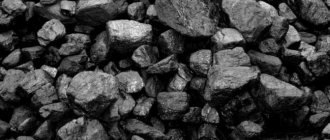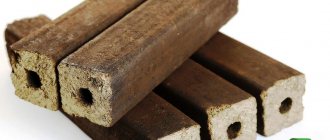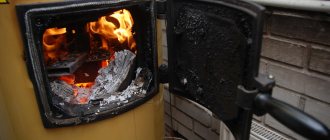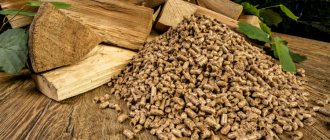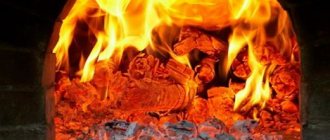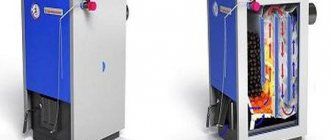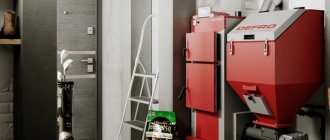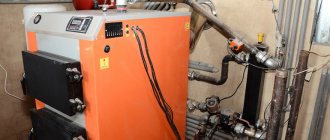Ease of use
Storage
Solid fuel must be stored in a designated place under certain conditions:
Pellets - put in plastic bags to protect from moisture; store in a dry place if the granules have high porosity.
Firewood - protected from rain and snow; ventilate so that dampness does not accumulate; make a base of boards to prevent mold from appearing.
Coal - store under a canopy at 20°C and below so that it does not oxidize; Protect with covering material to prevent self-ignition.
The gas tank is filled a couple of times a year, then the gas itself runs through the pipes. The reservoir is buried underground and does not take up space on the site.
Loading fuel
Firewood and coal need to be loaded constantly. Therefore, these works are often performed by the stokers of our time - guests of the capital.
Fuel pellets do not require constant loading, the normal mode is once a week. But still, the pellets themselves do not yet jump into the boiler. There is an automated boiler - “carborobot”. You can take a closer look at it.
The gas tank is refilled once every six months, most often in the fall. Each stage is strictly regulated, you only need to open the gate. The gas carrier will travel along any road, the tank will be filled in 1-2 hours. You can also save on gas stations.
Note: TT is a solid fuel.
Waste and cleaning
Combustion with coal and wood means smoke, cinders, soot, soot, tar, ash, ash. That is, equipment cleaning operations once every 2 weeks.
Wood ash dumps can be used as fertilizer in the garden; coal ash can be used to fill holes in the primer. Or call a recycler - this will add a regular expense item.
Experts inspect the gas tank twice a year: in spring and autumn. If necessary, cosmetic repairs are carried out.
Gas tank technical inspections
After installation, you enter into a contract for 1 year of free service. The service includes 2 preventative engineer visits in the fall and spring and 1 emergency call within 24 hours.
Then the agreement can be renewed for 12,000 rubles per year. Or use the one-time inspection service for 3,500 rubles. An unscheduled emergency departure costs 5,000 rubles.
Efficiency
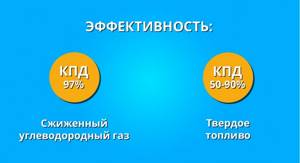
Efficiency of pellets, coal and firewood
For how many centuries they warmed themselves with wood and coal - they did not complain about the cold. Do you need to heat two floors, not a hut? 1 kg of peat pellets burns like 1.6 kg of wood. True, there will still be difficulties with a large house.
Do you know why? Just one word: stoker. This is the person who will add fuel to the stove for you around the clock. No way without a stoker. You left for work and the oven was cooling down. We went to bed - the house was cold in the morning.
The efficiency of heating with wood, coal and even pellets decreases sharply if you count the labor costs for loading fuel. And also waste. Coal produces ash dumps on which you will have to spend your legal day off.
When 1 kg of solid fuel is burned, 5 kW of thermal energy is released. For a house of 100 sq. m need 10 kW per hour, that is, 2 kg of pellets or coal every 60 minutes. Someone has to provide this fuel, even if not so often.
Heating with wood and its analogues is very fussy: find, order, load, monitor, clean, remove waste. But everything is classic + exercise and discipline.
An effective system can be set up: choose a carborobot or a pellet boiler with automatic feeding, and schedule a fuel loading schedule. You will need money, free time and self-organization.
The efficiency of a solid fuel boiler is 50-90%. The variation in efficiency depends on the heat loss of the house, the caloric content of the fuel and other factors. This is a very low efficiency compared to electric boilers and equipment running on natural or liquid gas.
Calculate yourself
When burning 1 kg of solid fuel, we obtain 5 kW of thermal energy. When burning 1 kg of liquefied gas, we get 12.8 kW.
LPG efficiency
The efficiency of the gas boiler is stable at 97%. The gas supply from the tank is smooth and fully automated. A house with gas heating does not depend on fluctuations in the network, pipeline accidents and fuel supplies, as is the case with firewood.
There is nothing to hide: autonomous gas is more efficient in all respects. All other things being equal, it provides 2.5 times more thermal energy. Therefore, a gas holder will be more expensive than good old firewood and coal, right? Let's do the math.
Eurodrova
Briquettes are made from waste from the food and wood processing industries: sawdust, seeds, buckwheat and rice husks, straw, peat and herbal plants.
The briquette composition is subjected to strong pressing and drying. Burning fuel briquettes does not harm human health, since they do not contain chemicals. There are three main forms of fuel briquettes: ruf, pini-kay and nestro.
They differ from each other only in maximum density, which directly depends on the shape, but there are no fundamental differences in the composition and calorific value of the material. Advantages of fuel briquettes:
- Low humidity and high density of the material, which ensures high heat transfer and long burning time (up to 4 hours).
- Compared to firewood, they are more compact to store due to their regular geometric shape.
- They do not spark or shoot when burned, emitting a minimal amount of smoke.
You can read about coal briquettes in this article.
You may also find this article about heat-resistant adhesive for ovens useful.
- Briquettes take a long time to warm up due to the high density of the material and leave a fairly large amount of ash.
- In the room where the stove is heated with briquettes, there is a pungent, specific burning smell.
- Fuel briquettes have very low moisture resistance and crumble under improper storage conditions.
- They are very unstable to mechanical damage, which makes them impossible to use further.
- Lack of aesthetic component when lighting a fireplace. Fuel briquettes can burn with a barely smoldering flame.
Qualities of suitable firewood
First you need to decide which qualities are positive, which are intolerant, and which are unimportant.
Sparks and crackling
When logs crack in a fire, it means that the wood is bursting under the heat and a small ember can fly off.
Sparks are very small embers carried away by smoke.
Both can cause a fire
Of course, when burning wood in a pyrolysis barrel (a closed container with little air supply to the wood), this is not important. But in nature or in a country house, where there may be easily flammable objects, such qualities of firewood must be taken into account
Deciduous wood cracks and sparks the least, while coniferous wood cracks and sparks the least.
Heat
The temperature and burning time of coal from different types of wood are not the same. Hard coals burn longer and hotter. The champion here is oak. Its coal burns longer and hotter.
Resin content
Many are convinced that everything in charcoal has already burned out and is pure carbon. But that's not true. Coal, like a sponge, absorbs the combustion substances of firewood and then releases them to the barbecue. The resins will give the meat a bitter taste. This doesn't suit us.
Resins are found in all conifers. And we can say for sure that there is no need to fry shish kebab on pine wood (on charcoal from it).
Aroma
Shish kebab on live coals is valued for its slight smoky flavor. The most “tasty” smoke comes from alder and fruit trees (pear, apple, cherry). Of course, the effect is much weaker than using wood chips in a grill, but connoisseurs claim that the difference is felt.
Rowan, poplar, acacia and elm are also not suitable. This firewood produces “heavy” smoke.

Your own coal for different dishes
The smoky flavor and the dish should suit each other.
Cherry - for hamburgers, lamb and poultry (especially duck).
Alder - for salmon/trout, turkey and chicken.
Apple tree - for game, pork, chicken and seafood.
Oak - for meat.
Maple firewood - for pork, seafood and chicken.
Birch - for chicken and any meat.
No impurities
If we didn’t like natural resins, then impregnated construction wood, scraps and old furniture won’t work either. Synthetic resins, adhesives and plastics contaminate coals. The result is a nasty taste and full of harmful chemicals on the meat.
Humidity
Why is moisture in logs bad?
Firewood burns longer (and unevenly) and during this time the coals that we need for barbecue partially burn out. Little or very little comes out. Choose dry ones.
Size
When burning wood for charcoal, the most efficient way is to pack the wood more tightly. This will increase the output.
Conclusion: size is important and you need to focus on your hearth, grill or barrel. Even for a fire, you need to cut dead wood into pieces of a suitable size.
More coal
Homemade or professional charcoal burners use special furnaces (pyrolysis).
You can estimate the yield of coal from wood of different species as follows:

If a pyrolysis oven is not used, then the coal yield is very different from the table.
Firewood that burns quickly and hot produces less coal than wood that burns evenly.
The former include birch and aspen, and the latter – durum varieties and fruit trees. Alder is somewhere in the middle.
Procuring coal is a long process and it is better to do it in advance. You can combine burning wood and cooking shish kebab on a grill with a firebox. Or use a ready-made one.
What are fuel briquettes?
Initially, the raw materials are crushed and then pressed under high pressure. Similar pellets are crushed even more, since they are environmental fuels. This is due to the fact that during the combustion process they emit into the air the same amount of carbon dioxide as is absorbed by the tree during its growth. Briquettes are characterized by increased density and large mass. They are ideal for heating a stove because they burn without leaving a residue.
p, blockquote 3,0,0,0,0 —>
p, blockquote 4,0,0,0,0 —>
Price
The cost of heating a house with pellets per 100 square meters. m
A ton of standard pellets costs an average of 8-9 thousand rubles. Let's take a price of 8,500 per ton. With a heating season lasting 8 months, we get:
heat loss - 28,224 kW/h;
pellet consumption - 5 t 644 kg;
in money - 47,980 rubles per season.
Calculate yourself
Prices for pellets in the Moscow region are 8.50 rubles per kg. The average winter price of 1 liter of liquefied gas is 21 rubles.
A ton of coal or fuel briquettes costs approximately the same as a ton of pellets. Firewood is a little cheaper. Additionally, consider the associated costs after installing the boiler:
Fuel delivery: from 7,000 rubles.
Waste removal: from 5,000 rubles.
Stoker's payment: from 10,000 rubles (without accommodation).
Gas holder heating: cost per month and season
Heating with liquid gas a house of 100 sq. m costs 4-5 thousand rubles per month when purchasing gas at a high winter price (21 rubles/l). For the heating season (8 months) it comes out to 40 thousand rubles. It turns out even cheaper than pellets with full automation and no waste.
Tip: choose a heating system based on the characteristics of the region. Somewhere there is forest and cheap firewood, somewhere it’s easier and more profitable to use coal. An autonomous gas tank is not tied to a location: LPG costs the same everywhere.
Cost of installing a gas holder and solid fuel boiler
We carried out an average calculation for the same house with an area of 100 square meters. m. The final price includes working equipment and heating throughout the year.
The cost of autonomous gasification did not include the purchase of a boiler. The range of offers is too wide: from 37 to 100 thousand rubles.
Equipment: Real-Invest gas tank with high pipes for 4,600 l.
Works: installation, sand delivery, digging with an excavator, soil removal (2 vehicles).
230,000 rubles
Equipment: long-burning solid fuel boiler Buderus Logano 124 201.
Work: boiler installation 12,000, additional installation up to 10,000.
146,201 rubles
Fuel refueling for a year
We multiply the full tank (enough for 12 months) by the cost of gas:
3,910 l x 21 rub./l = 82,110 rubles
We multiply the cost of fuel per month by 12:
6,000 rubles x 12 = 72,000 rubles
1,500 rubles
Included in installation
Reconfiguring the boiler for LPG
12,000 rubles + set of nozzles (depending on the boiler model from 2 to 8-9 thousand rubles)
Delivery (in the Moscow region)
1,000-3,000 rubles
335,000 rubles. Gas is automatically supplied to the system
221,201 rubles. You need to throw pellets into the system once a week
Is it better to heat a stove with coal or wood?
In the Moscow region, many different types of solid fuel are sold that are used in stoves. Starting from the popular: firewood, pellets, briquettes and coal and ending with the rare: dung and peat briquettes. At the moment, according to independent research, the most popular types of fuel are coal and firewood. Moreover, both wood and coal have their own advantages and disadvantages, which should be taken into account when choosing and purchasing fuel.

Coal is a mineral, a type of fuel formed from parts of ancient plants underground without access to oxygen. The international name for carbon comes from lat. carbō ("coal"). Coal was the first fossil fuel used by humans. It enabled the industrial revolution, which in turn contributed to the development of the coal industry, providing it with more modern technology.
On average, burning one kilogram of coal leads to the release of 2.93 kg of CO2 and produces 23-27 MJ (6.4-7.5 kWh) of energy or, with an efficiency of 30%, 2.0 kWh of electricity . Coal can be of different grades - brown, black and the best - anthracite. The latter releases more heat during combustion and less is required to achieve the required temperature.
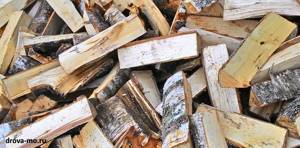
Firewood - pieces of wood - timber - intended for burning in a stove, fireplace, firebox or fire to produce heat and light. In accordance with the requirements of GOST 3243-88, the quality of firewood in Russia is standardized by wood species, nominal length and accounting gradation, by the area of core rot (as a percentage of the end area), by the amount of firewood in a batch with rot from 30 to 65% of the end area, and by the height of the remaining branches.
So, let’s return to the question that concerns us: what is better, wood or coal for heating?
Coal is well suited for combustion in heating system boilers installed in separate rooms, outbuildings or a separate boiler room. It is not recommended to use it in stoves installed in residential premises. Since coal burns for a long time and practically does not burn completely in the furnace firebox, and therefore you cannot close the chimney, you always have to leave it a little open so as not to get burned by carbon monoxide. At the same time, dry wood burns quickly and provides enough heat to warm up the stove. The firewood burns to the end, and you can safely close the valve on the pipe and thereby slow down the cooling of the stove and the loss of heat through the chimney.
It is very difficult to light coal without logs or special ignitions. Therefore, even those who heat their stoves with coal still buy wood to ignite coal. The best firewood in terms of heat transfer is oak firewood, but they are expensive, so birch firewood is optimal in terms of price/heat transfer ratio.
People who burn coal know very well that coal dust is harmful to the human body. And when throwing the next batch of coal into the firebox, it is rarely possible to “not raise dust” and not stain everything around with coal dust. Firewood is mostly free of dirt and foreign impurities.
Wood heating is the most environmentally friendly compared to coal. Since the combustion of wood releases a minimal amount of carbon dioxide, it cannot cause much harm to the biosphere, compared to coal.
Therefore, when you choose between coal and firewood, we strongly advise you to choose firewood. This is both safer for health and more profitable from the point of view of maintaining cleanliness in the house.
When and what fuel is better?
First of all, the choice depends on the boiler itself and the capabilities of the owner.
Wood is perfect for those who have the strength, time and means to organize its storage. The harvesting process is quite labor-intensive. If you purchase logs, you need to saw them, split them, and put them indoors. It’s easier with ready-made logs, but they will cost much more. But you can be sure that such fuel is available in almost any locality.
Coal, due to its unpretentiousness, is suitable for those who like to save their time . It can be poured onto a separate area, covered with some material, without worrying about its condition. All you have to do is come, take the required amount and load it into the boiler. And the duration of combustion eliminates the need for too frequent monitoring of the heating process.
Each of these fuels is good in its own way. The main thing to remember is the technical capabilities and operating conditions. Then the heated room will always be warm and cozy.
Reliability
A solid fuel boiler operates stably under 2 conditions: there is a supply of fuel and the one who fills it up. Just like a classic stove, you can completely rely on such a boiler. You just need to monitor his condition.
Advice: one of the undoubted advantages of solid fuel boilers is the ability to heat with anything when there are no pellets or coal. You can wait for fuel to be delivered on wood chips, a file of Maxim magazine, and the wall of an old barn.
The autonomous gas tank is extremely reliable. It evaporates gas non-stop even in temperatures below 40 degrees. The human factor in the case of liquid gas is excluded. With proper installation and operation, there can be no interruptions.
